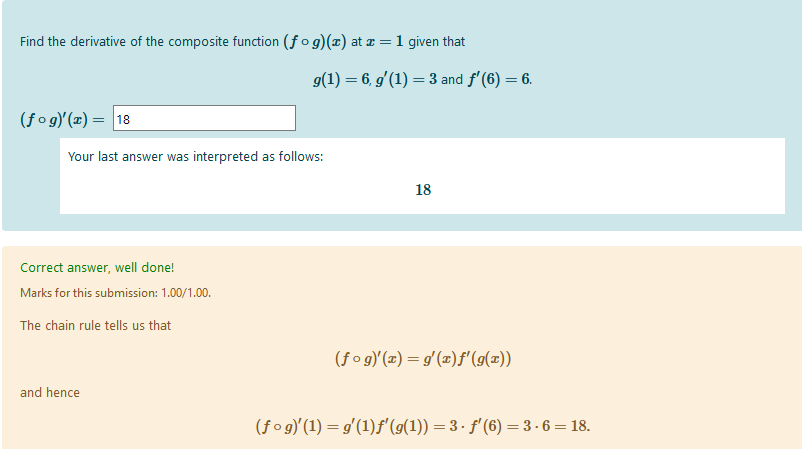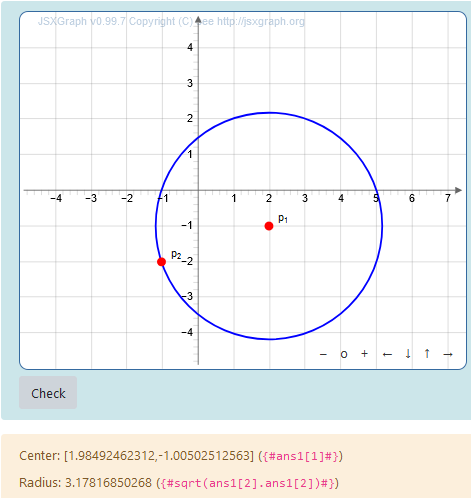{lang=EN}
JSXGraph and STACK
What is STACK?
STACK is an open-source computer aided assessment system for mathematics and related sciences. Although STACK includes multiple answer types its main focus is on student-provided mathematical expressions. This means that the student's answer to a question can for example be a polynomial or a matrix.
To evaluate mathematical expressions STACK uses the computer algebra system (CAS) Maxima.
The STACK system provides a new question type for Moodle and ILIAS learning environments. STACK can also be integrated to other learning environments via LTI.
This is what a typical STACK question looks like:

🔗 About STACK
STACK questions and JSXGraph
Firstly, we strongly recommend you do not use any HTML-aware (WYSIWYG) editor when working with questions including JSXGraph. Switch to the plain text editor instead to edit the raw HTML.
The key differences
Graphs that do not need to remember their states between page reloads are basically built just like you would do with the official JSXGraph filter. Note however that STACK does not require this filter to be installed as STACK provides its own implementation with some key differences and additional features:
-
STACK does not allow you to name the div-container element the graph is stored in. Instead STACK automatically generates an identifier that is then stored in a variable named
divid(alsoboardidsince STACK 4.3.3). Thus a JSXGraph Board in STACK is created like this:var board = JXG.JSXGraph.initBoard(divid, { ... });This is done in order to avoid accidental identifier clashing in cases when there are multiple copies of the same question on the same page.
-
Instead of traditional div-elements the JSXGraphs in STACK start and end with STACK style question blocks
[[jsxgraph]]and[[/jsxgraph]]respectively. You can control the size of the JSXGraph container with the width and height options. For example,[[jsxgraph width="450px" height="350px"]]
Input bindings
STACK provides a way to reference the input fields of the question and also provides identifiers for these input elements if requested. For example, in order to create an identifier for an input field with the default name ans1 we would refer to it within the question block like this:
[[jsxgraph input-ref-ans1='ans1Ref']]
After doing so there are multiple ways we can work with the input . The most obvious way is to use some of the STACK specific input binding functions.
1. Straightforward binding
With the straightforward binding function stack_jxg.bind_point(ans1Ref, p1) we can bind the coordinates of a JSXGraph point element with the value of the input field ans1.
Example code:
[[jsxgraph input-ref-ans1='ans1Ref']]
var board = JXG.JSXGraph.initBoard(divid, { boundingbox : [-5, 5, 5, -5], axis : true });
var p1 = board.create('point', [-2, -2], { name : 'bound' });
var p2 = board.create('point', [2, 2], { name : 'free' });
stack_jxg.bind_point(ans1Ref, p1);
board.update();
[[/jsxgraph]]
2. Dual binding
There are two different STACK specific functions for representing vectors, lines, circles or anything that can be defined by two points.
The STACK specific function stack_jxg.bind_point_dual(ans1Ref, p1, p2) allows you to bind two points to an input returning their coordinates as a list of lists.
Example code:
[[jsxgraph input-ref-ans1='ans1Ref']]
var board = JXG.JSXGraph.initBoard(divid, { boundingbox : [-5, 5, 5, -5], axis : true });
var p1 = board.create('point', [-2, -2], { name : 'p_1' });
var p2 = board.create('point', [2, 2], { name : 'p_2' });
board.create('segment', [p1, p2], { fixed : true, strokeWidth : 4, strokeOpacity : .6 });
stack_jxg.bind_point_dual(ans1Ref, p1, p2);
board.update();
[[/jsxgraph]]
3. Relative binding
The STACK specific function stack_jxg.bind_point_relative(ans1Ref, p1, p2) works similarly to the aforementioned bind_point_dual function but returns the coordinates of the latter point relative to the initial point, i.e. [p2.X()-p1.X(), p2.Y()-p1.Y()].
Example code:
[[jsxgraph input-ref-ans1='ans1Ref']]
var board = JXG.JSXGraph.initBoard(divid, { keepaspectratio : true, axis : true });
var p1 = board.create('point', [0, 0], { name : 'p_1' });
var p2 = board.create('point', [2, 0], { name : 'p_2' });
var ci = board.create('circle', [p1, p2]);
stack_jxg.bind_point_relative(ans1Ref, p1, p2);
board.update();
[[/jsxgraph]]

4. Slider binding
It is also possible to bind the value of a slider element with user input using the STACK specific function stack_jxg.bind_slider(ans1Ref, s1).
Example code:
[[jsxgraph width='500px' height='500px' input-ref-ans1='ans1Ref']]
var board = JXG.JSXGraph.initBoard(divid, { boundingbox : [-10, 10, 10, -10], axis : true, shownavigation : false });
var p1 = board.create('point', [0, 0], { name : 'move me!', size : 4, strokeColor : 'black' });
var s1 = board.create('slider', [[3, 8], [8, 8], [1, 4, 7]], { label : 'radius' });
stack_jxg.bind_slider(ans1Ref, s1);
var c1 = board.create('circle', [p1, function() { return s1.Value(); }] , { fillColor : 'orange', fillOpacity : .5 });
board.update();
[[/jsxgraph]]
5. Dynamic binding
As the subject of dynamic binding is rather technical and laborious we won't go into great lengths detailing it here as this is supposed to be a more or less quick introduction. To put it briefly, if your question must have a dynamic number of objects each bound to an input field it is easy to notice that the one-to-one input-object-binding described in the previous examples will not suffice. For more varied data (say you want to store the state of some JavaScript objects, lists, dictionaries etc.) what you can do is to convert the data to JSON strings, which can then be stored into String type input fields. In order to parse this data STACK provides the function stackjson_parse(state).
One way and two way binding
In all of the examples given above we used what is referred to as one way binding, that is to say, the binding transfers some data from the JSXGraph element over to the user input and then retrieves this stored value whenever the page is reloaded.
In addition to this, STACK also uses two way binding which means that we can continue to keep track of the input value even after the page has been loaded so that if its value is changed due to any action, this change is also conveyed into the graph.
As a useful consequence of this feature we can have multiple graphs with objects bound to the same input and have the objects move in sync when some action is performed on any one of them.
{/lang} {lang=SI}JSXGraph and Stack{/lang}{lang=CZ}JSXGraph and Stack{/lang}